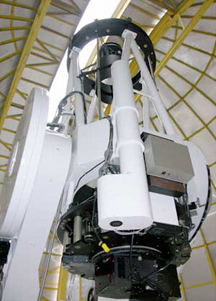42-inch Hall Telescope
Location
Anderson Mesa
Dark Sky Site
Overview
Named after long-time Lowell Observatory Director John Hall, the 42-inch Hall Telescope has played a key role in the study of comets and asteroids, as well as the Sun and Sun-like stars.
About the Hall Telescope
This 42-inch (1.1-meter) fork-mounted telescope has for more than a half century been a workhorse telescope at Lowell’s Anderson Mesa Dark Sky Site, located a dozen miles southeast of Flagstaff. It is named after John S. Hall, fifth director of Lowell Observatory (no relation to current Director Jeff Hall). The telescope came about as a replacement for the 42-inch Lampland Telescope, which was housed on Mars Hill in the structure affectionately called the Jiffy Pop dome by staff members, due to its similar appearance to the popular popcorn product.
The Hall Telescope and dome were built in 1968-69 and regular use began in 1970. The facility has been in regular use since then. The telescope is located on an upper floor and the dome features a catwalk that allows astronomers to easily go outside to check on weather conditions. The telescope has an f/8 Ritchey-Chretien optical configuration and was upgraded in 2004 with a lightweight Hextek primary mirror.
The Hall Telescope has three associated instruments, which optimize it for CCD imaging and spectroscopy. Astronomers have used it especially to study the motion and rotation rate of asteroids and comets, the composition of comets, and the long-term behavior of the Sun and Sun-like stars.
Research with the Hall Telescope

Opened in 1970 at Lowell Observatory’s Anderson Mesa Site, the 42-inch Hall Telescope has been key in studying comets and asteroids as well as studying long-term behavior of the Sun and Sun-like stars.